

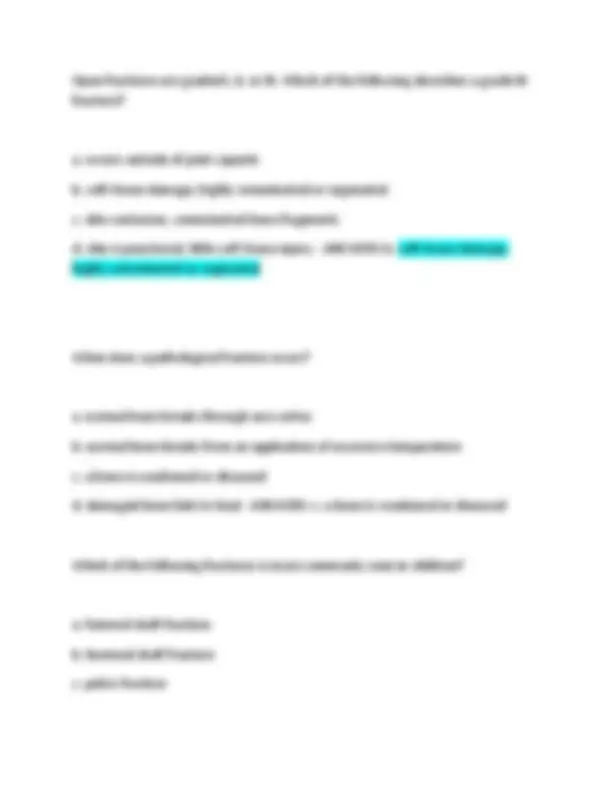
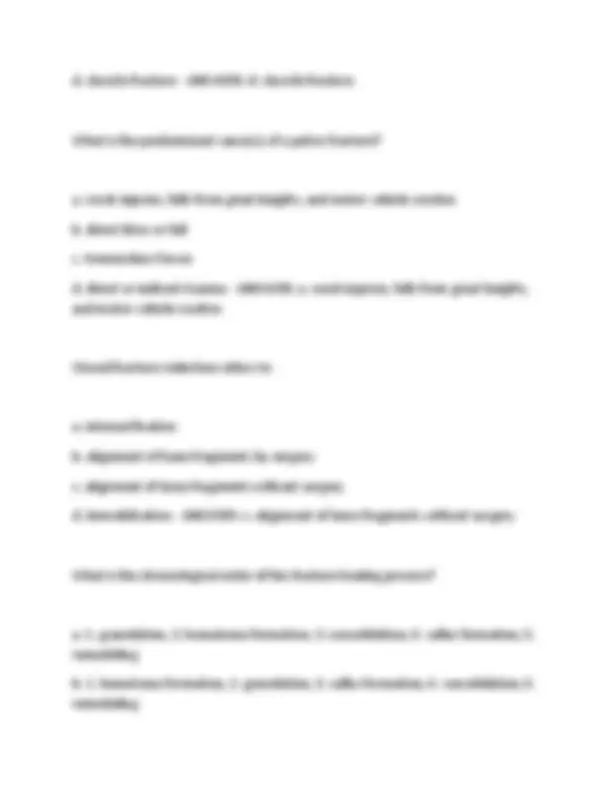
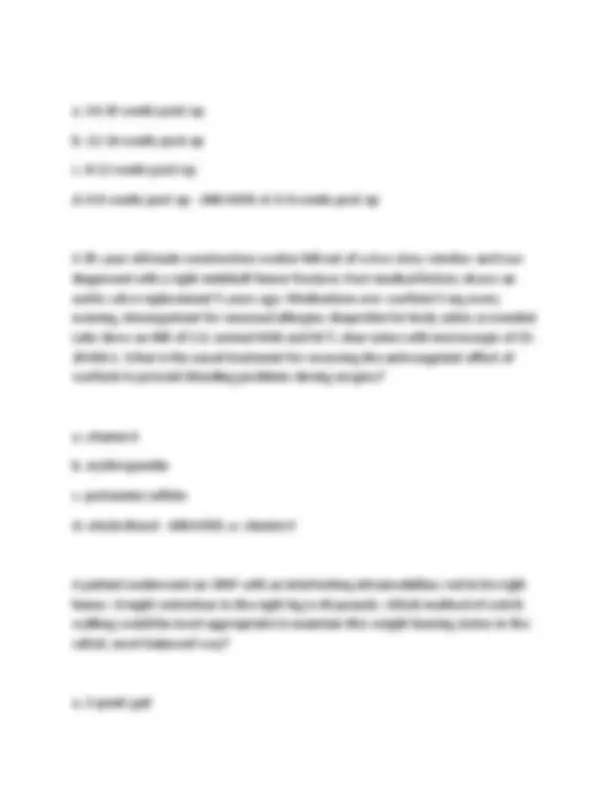
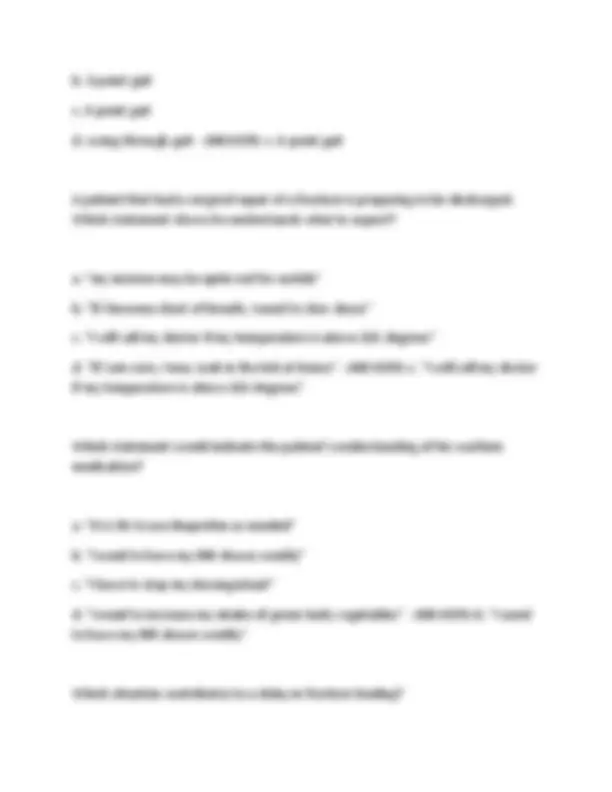

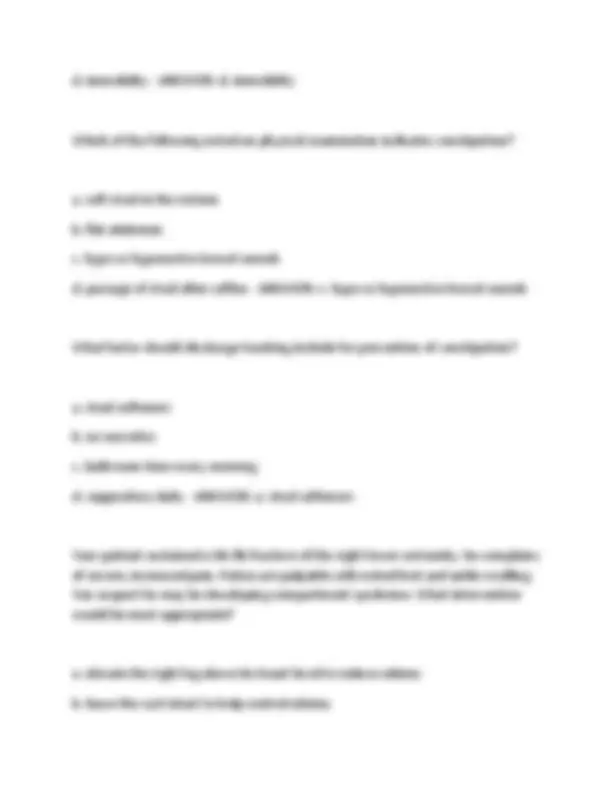
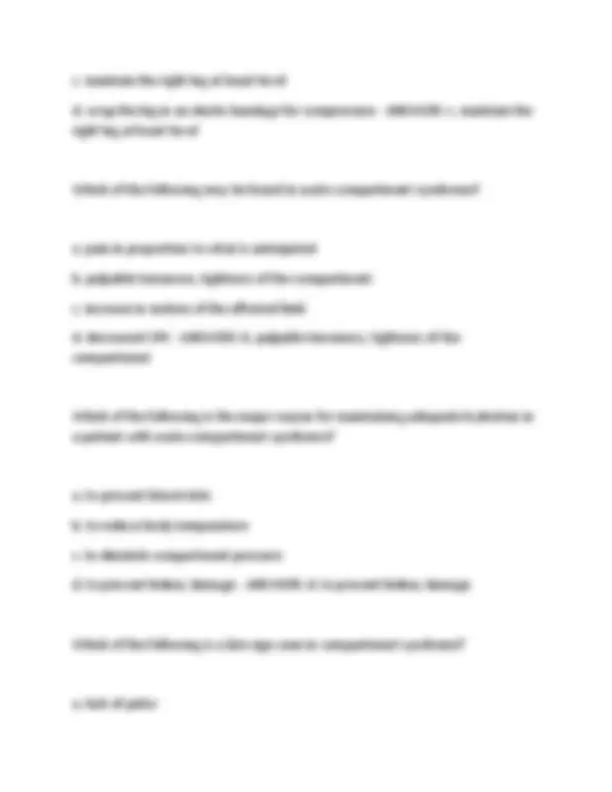
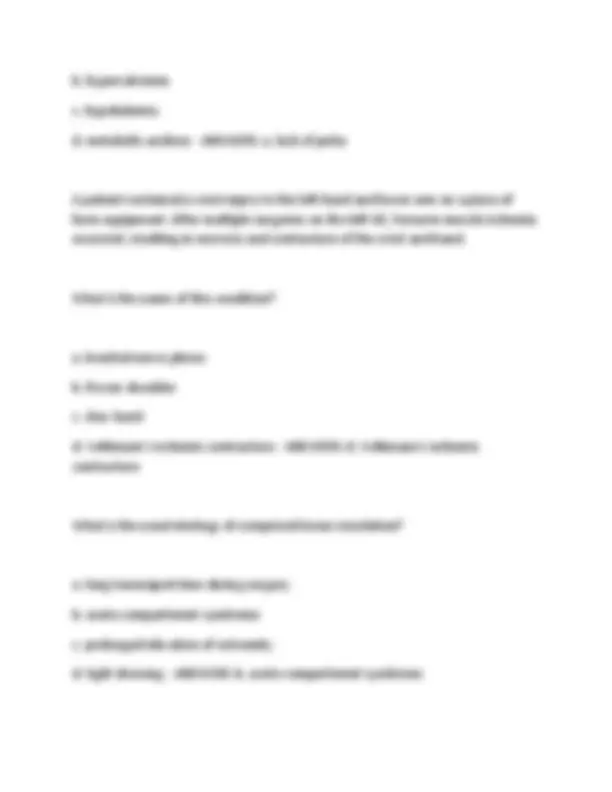
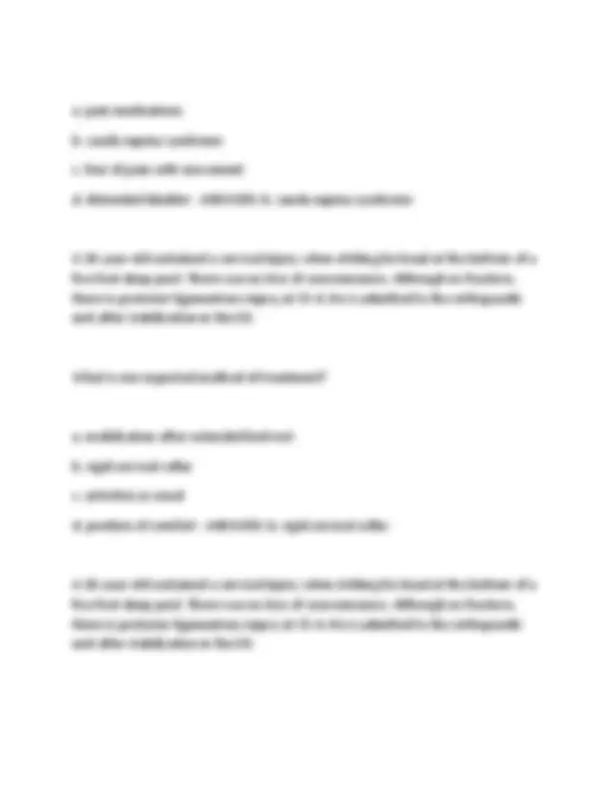
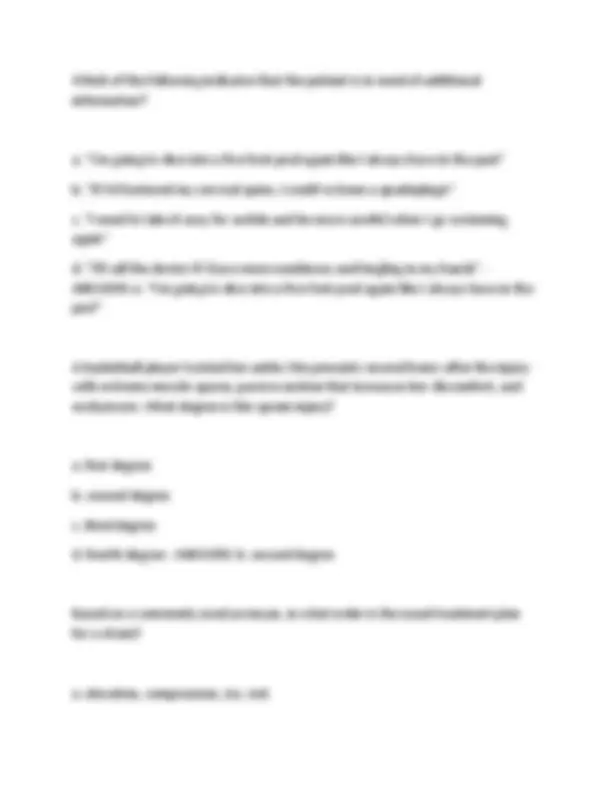
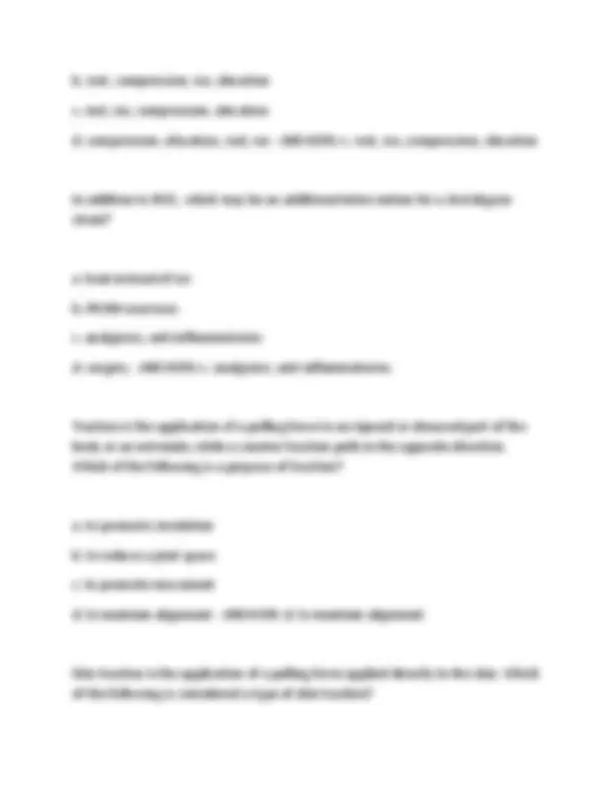
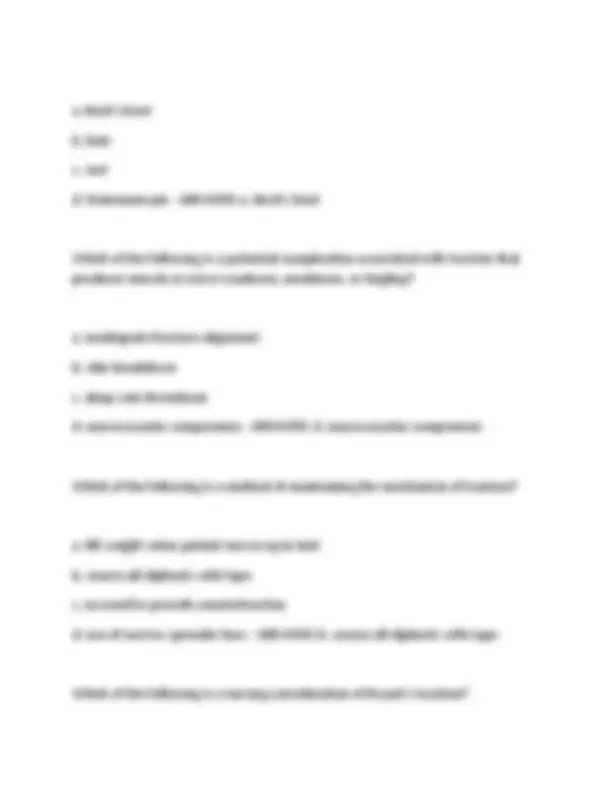
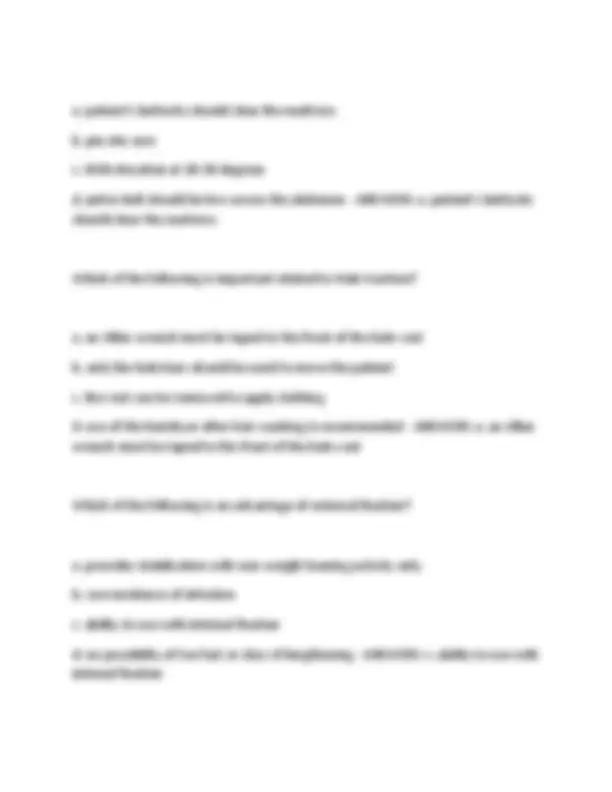
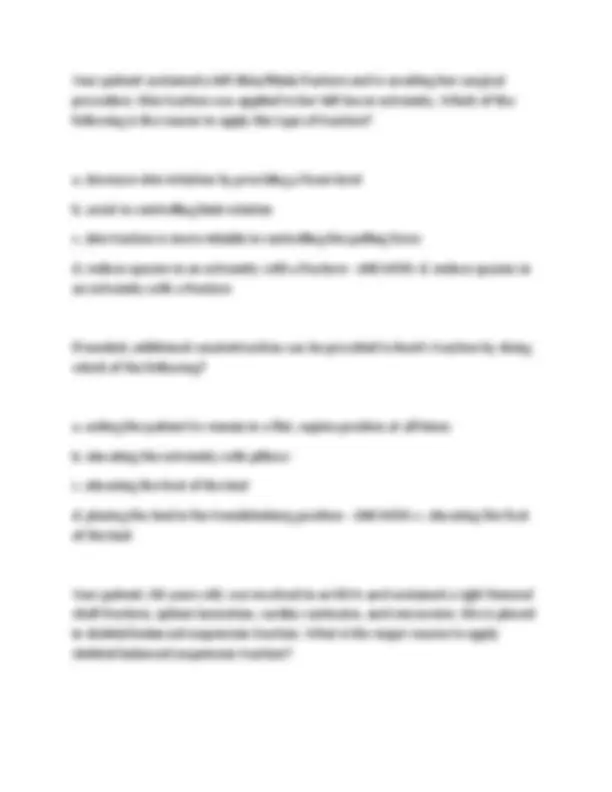
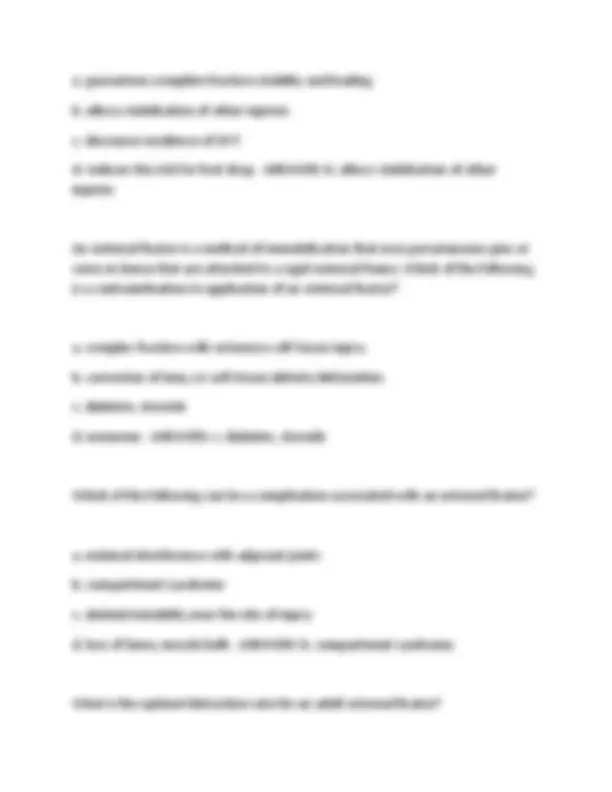
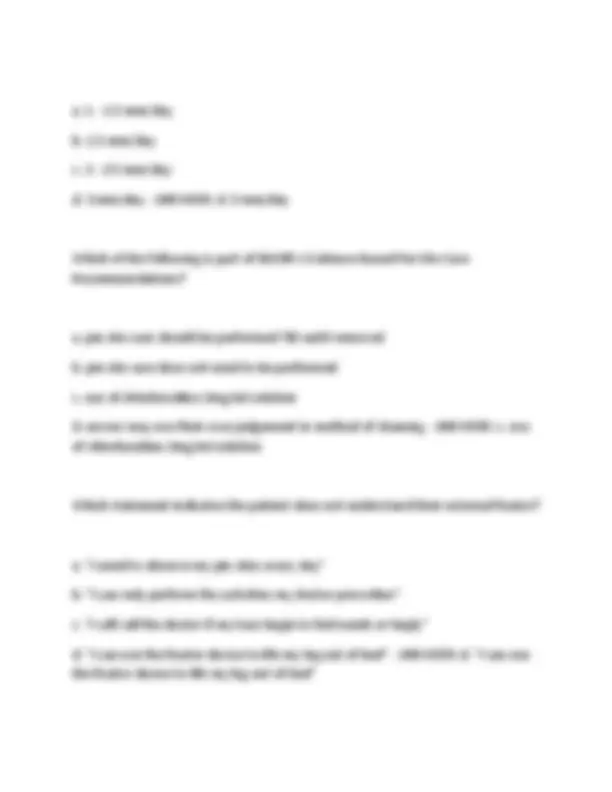
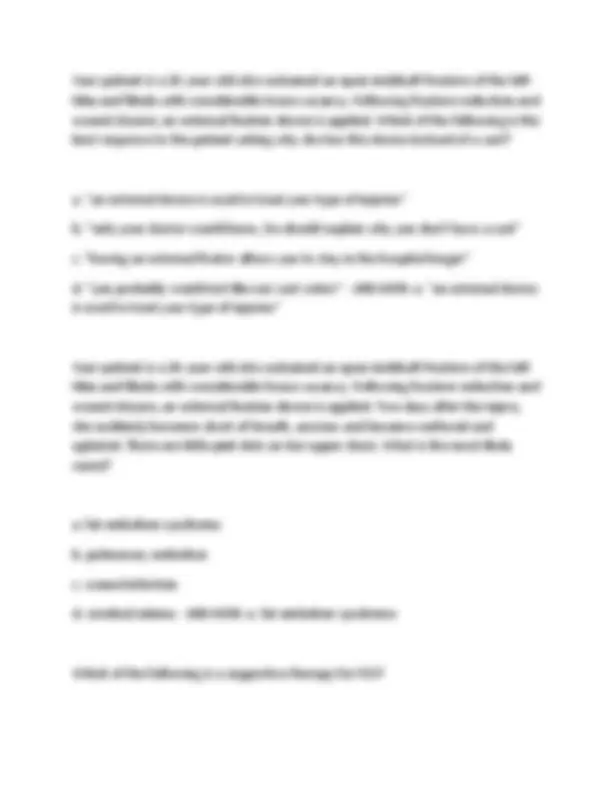
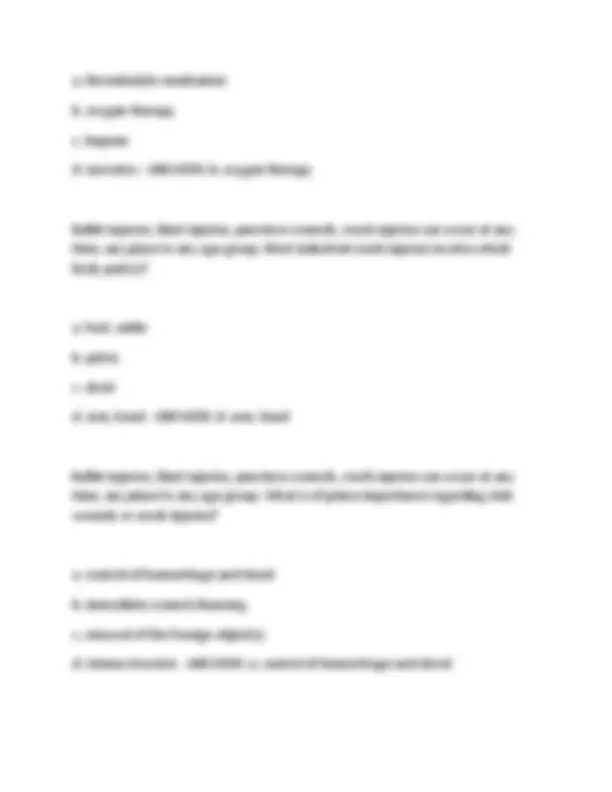
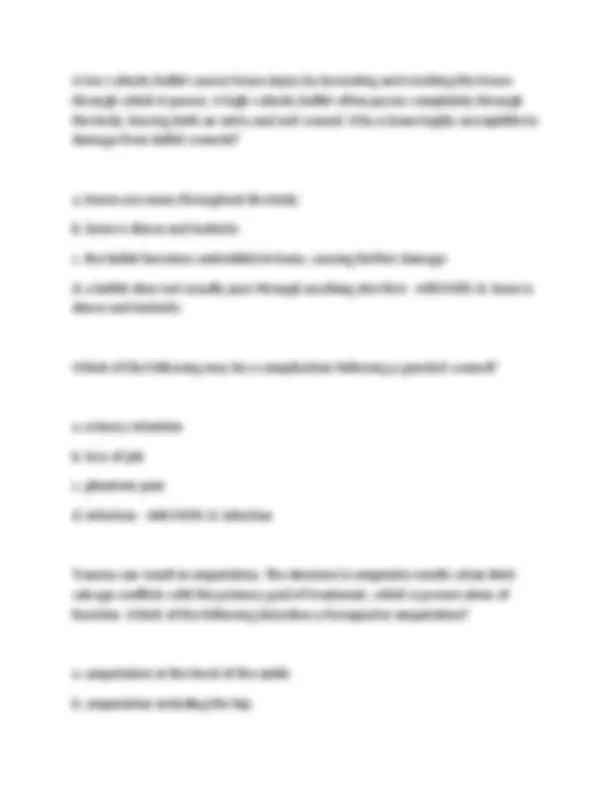
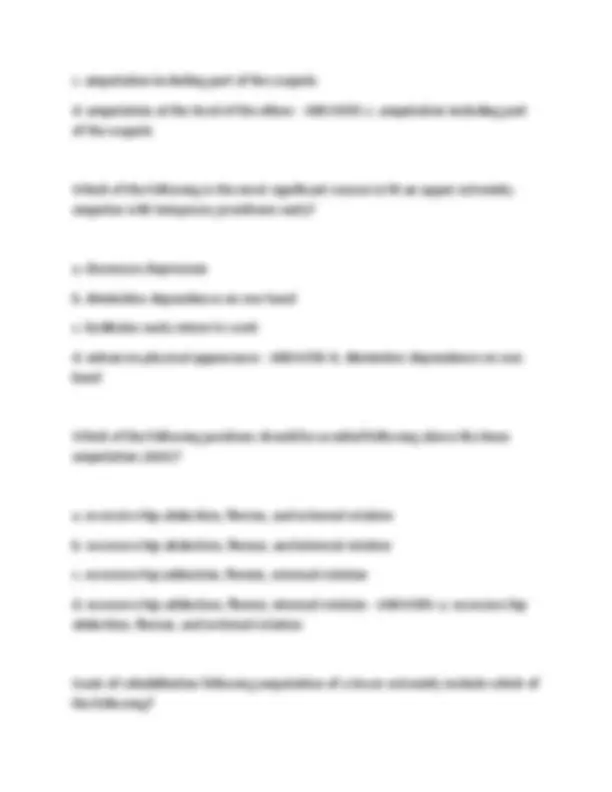
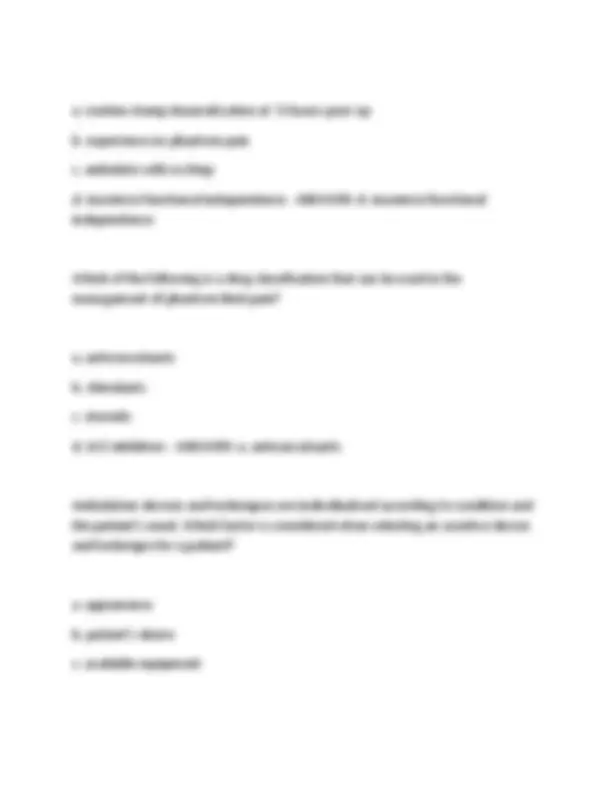
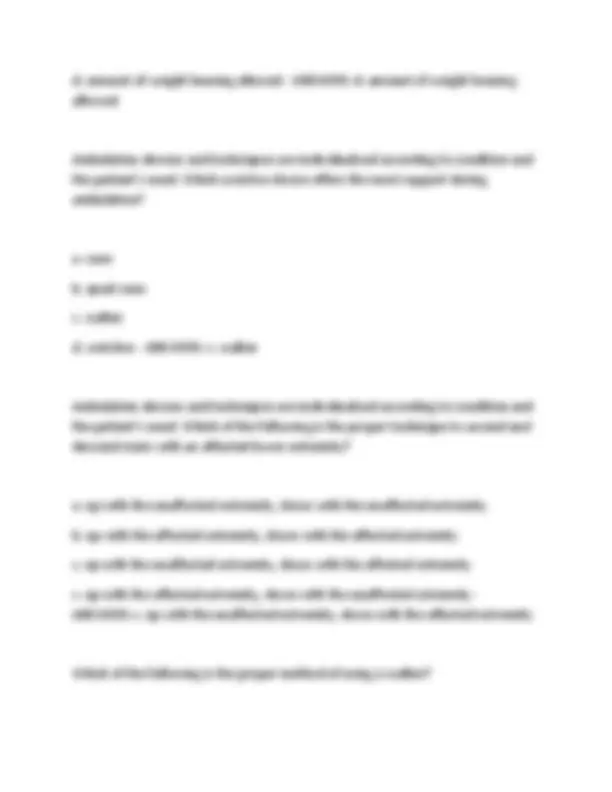
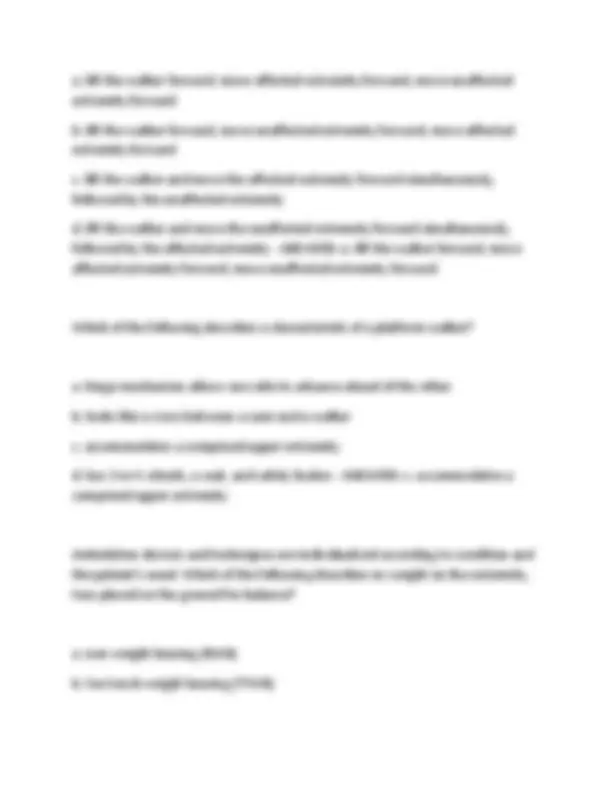
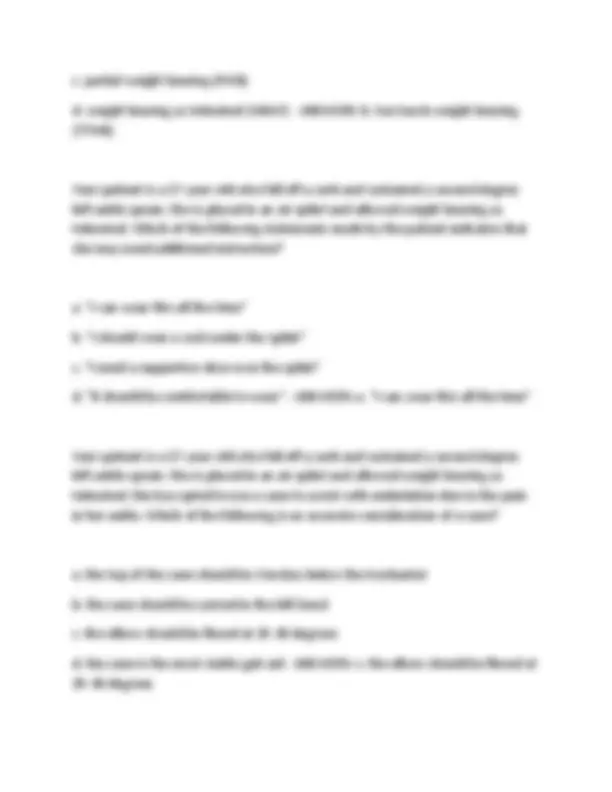
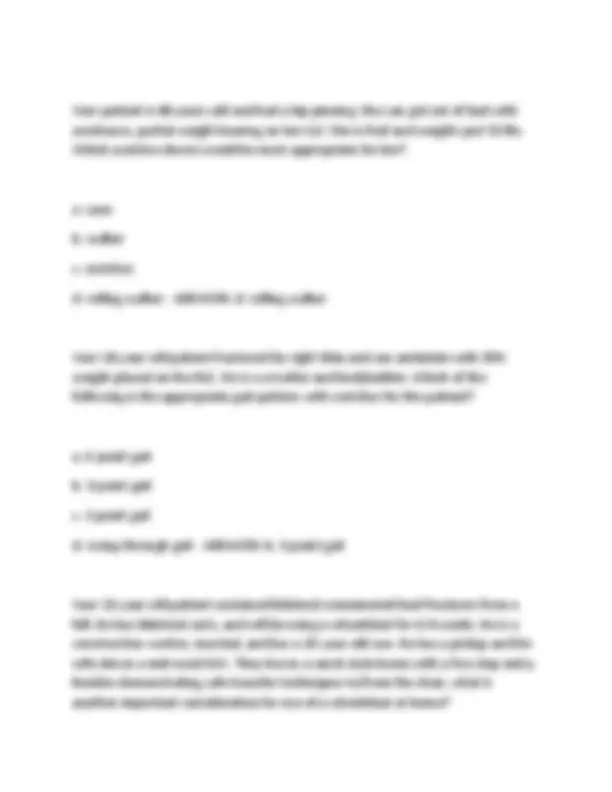
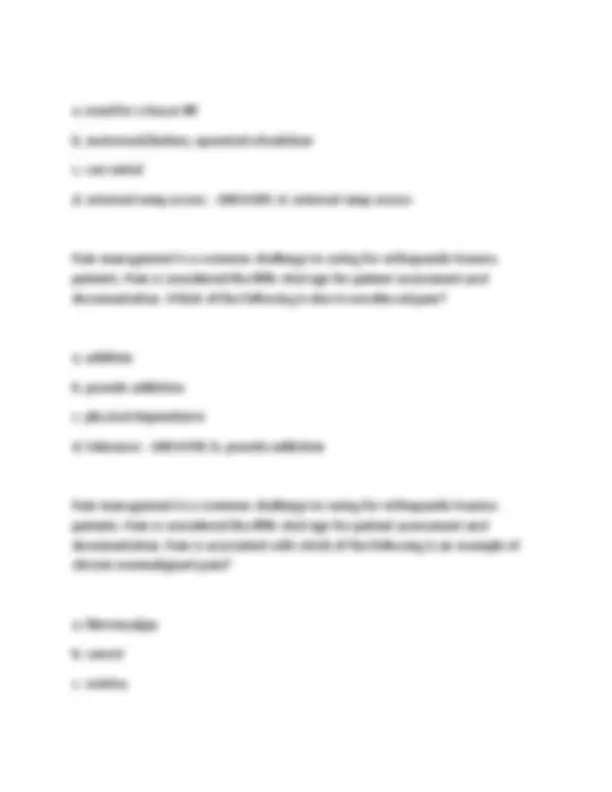
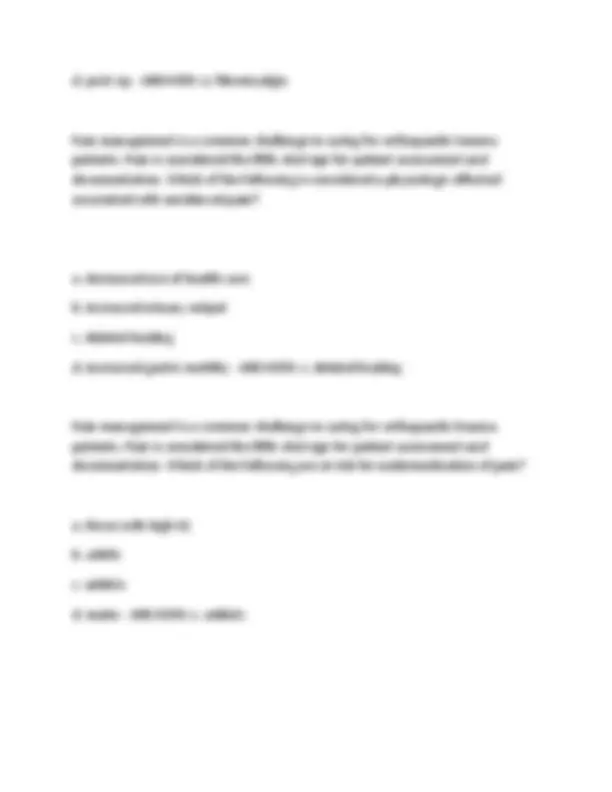
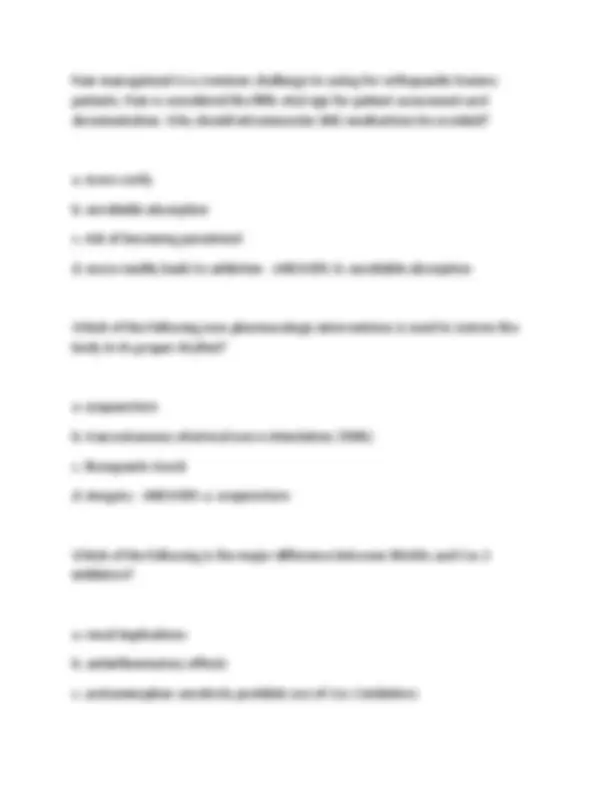
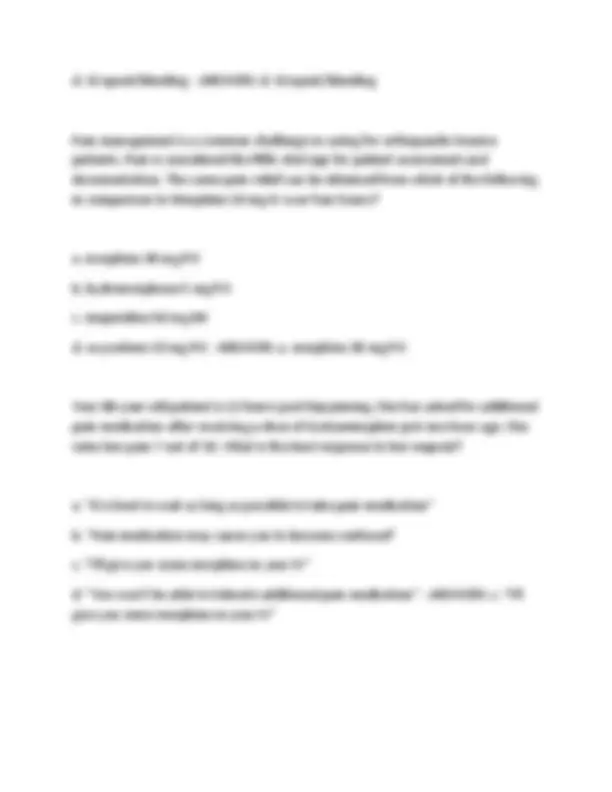
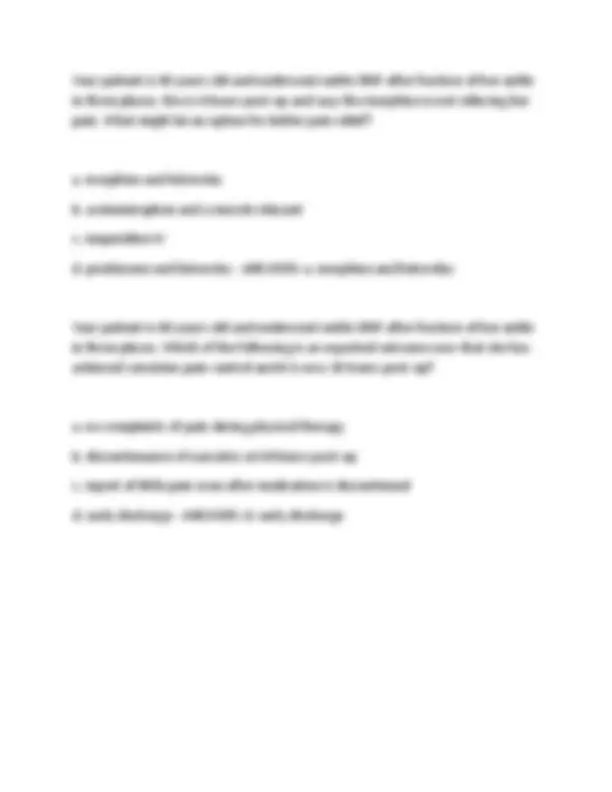


Study with the several resources on Docsity

Earn points by helping other students or get them with a premium plan


Prepare for your exams
Study with the several resources on Docsity

Earn points to download
Earn points by helping other students or get them with a premium plan
Community
Ask the community for help and clear up your study doubts
Discover the best universities in your country according to Docsity users
Free resources
Download our free guides on studying techniques, anxiety management strategies, and thesis advice from Docsity tutors
A series of multiple-choice questions and answers related to orthopaedic trauma practice. It covers various aspects of fracture management, including cast care, fracture healing, and complications. The questions are designed to assess knowledge of common orthopaedic conditions and treatments.
Typology: Exams
1 / 39

This page cannot be seen from the preview
Don't miss anything!
































Which of the following is an orthopaedic concern for Mrs. Barnes, a patient who is in lower extremity traction?
a. hip flexion contracture b. tibial nerve palsy c. joint laxity d. cast syndrome - ANSWERS-a. hip flexion contracture
A cast is a temporary, circumferential, rigid device used to immobilize an extremity to aid in the healing of fractures. In which of the following situations would it be appropriate to split or window a cast?
a. there is drainage coming through the cast b. the patient is complaining of their skin itching under the cast c. the patient is complaining of pain and there is swelling noted d. the cast edges are rough and irritating - ANSWERS-c. the patient is complaining of pain and there is swelling noted
For cast removal, which statement should the nurse explain to the patient?
a. "the saw can be very noisy and may become warm" b. "your arm will look like it did before the cast was applied" c. "you may return to normal activities once the cast is removed" d. "once the cast is removed, you will not need need to perform any skin care" - ANSWERS-a. "the saw can be very noisy and may become warm"
Which of the following is the most common mechanism/cause of injury for an upper extremity fracture/dislocation?
a. bone tumor b. car accident c. overuse d. direct blow or fall - ANSWERS-d. direct blow or fall
Open fractures are graded I, II, or III. Which of the following describes a grade III fracture?
a. occurs outside of joint capsule b. soft tissue damage, highly comminuted or segmental c. skin contusion, comminuted bone fragments d. skin is punctured, little soft tissue injury - ANSWERS-b. soft tissue damage, highly comminuted or segmental
When does a pathological fracture occur?
a. normal bone breaks through one cortex b. normal bone breaks from an application of excessive temperature c. a bone is weakened or diseased d. damaged bone fails to heal - ANSWERS-c. a bone is weakened or diseased
Which of the following fractures is more commonly seen in children?
a. femoral shaft fracture b. humeral shaft fracture c. pelvic fracture
d. clavicle fracture - ANSWERS-d. clavicle fracture
What is the predominant cause(s) of a pelvic fracture?
a. crush injuries, falls from great heights, and motor vehicle crashes b. direct blow or fall c. tremendous forces d. direct or indirect trauma - ANSWERS-a. crush injuries, falls from great heights, and motor vehicle crashes
Closed fracture reduction refers to:
a. internal fixation b. alignment of bone fragments by surgery c. alignment of bone fragments without surgery d. immobilization - ANSWERS-c. alignment of bone fragments without surgery
What is the chronological order of the fracture healing process?
a. 1. granulation; 2. hematoma formation; 3. consolidation; 4. callus formation; 5. remodeling b. 1. hematoma formation; 2. granulation; 3. callus formation; 4. consolidation; 5. remodeling
A 76-year-old, 90 lb., 5'7" female presents to the ED via ambulance with an externally rotated, shortened right leg and deformity of the right thigh. The patient states she tripped and fell the night before. Anterior/posterior and lateral films were taken of the right hip, showing an intertrochanteric fracture. Past medical history includes mild hypertension, treated with furosemide 40mg daily. A hemiarthroplasty is scheduled immediately and she is admitted to the orthopaedic trauma unit post-op. She undergoes posterior approach total hip arthroplasty because of the condition of her hip joint. Her doctor orders that she be turned to the left side only. What is the rationale for this order?
a. decrease incisional swelling b. prevent hip dislocation c. control pain d. facilitate wound drainage - ANSWERS-b. prevent hip dislocation
Which of the following would predispose the hip to dislocation?
a. position hip in extreme flexion, adduction or internal rotation b. turn with pillows to maintain abduction c. HOB no > 45-60 degrees d. out of bed to the chair - ANSWERS-a. position hip in extreme flexion, adduction or internal rotation
When is a post arthroplasty dislocation most likely to occur?
a. 16-24 weeks post op b. 12-16 weeks post op c. 8-12 weeks post op d. 0-8 weeks post op - ANSWERS-d. 0-8 weeks post op
A 35-year-old male construction worker fell out of a two story window and was diagnosed with a right midshaft femur fracture. Past medical history shows an aortic valve replacement 5 years ago. Medications are: warfarin 5 mg every evening, decongestant for seasonal allergies, ibuprofen for body aches as needed. Labs show an INR of 2.6, normal HGB and HCT, clear urine with microscopic of 15- 20 RBCs. What is the usual treatment for reversing the anticoagulant effect of warfarin to prevent bleeding problems during surgery?
a. vitamin K b. erythropoietin c. protamine sulfate d. whole blood - ANSWERS-a. vitamin K
A patient underwent an ORIF with an interlocking intramedullary rod in his right femur. Weight restriction to the right leg is 40 pounds. Which method of crutch walking would be most appropriate to maintain this weight bearing status in the safest, most balanced way?
a. 2-point gait
a. anatomic reduction b. smoking cessation c. surgical excision of bone d. early weight-bearing with long bone fractures - ANSWERS-c. surgical excision of bone
What is one way to avoid limb-length discrepancy in a child less than 8 years of age?
a. set fracture ends in an overlapping fashion b. do not limit activity c. allow full weight bearing activity d. use closed reduction more often than open reduction - ANSWERS-a. set fracture ends in an overlapping fashion
Which nerve injury can result in a wrist drop?
a. brachial nerve b. median nerve c. ulnar nerve d. radial nerve - ANSWERS-d. radial nerve
Which nerve injury can result in foot drop?
a. tibial nerve b. sural nerve c. peroneal nerve d. sciatic nerve - ANSWERS-c. peroneal nerve
In the case of avascular necrosis (AVN) of the femoral head, which of the following may be found upon the patient's physical exam?
a. limitations in internal rotation and abduction of the right leg b. limitations in external rotation and adduction of the right leg c. limitations in internal rotation and adduction of the right leg d. limitations in external rotation and abduction of the right leg - ANSWERS-a. limitations in internal rotation and abduction of the right leg
Which of the following is considered to be conservative management of AVN?
a. steroids b. non-weight bearing activity c. partial weight bearing d. hip spica brace - ANSWERS-b. non-weight bearing activity
d. immobility - ANSWERS-d. immobility
Which of the following noted on physical examination indicates constipation?
a. soft stool in the rectum b. flat abdomen c. hypo or hyperactive bowel sounds d. passage of stool after coffee - ANSWERS-c. hypo or hyperactive bowel sounds
What factor should discharge teaching include for prevention of constipation?
a. stool softeners b. no narcotics c. bathroom time every morning d. suppository daily - ANSWERS-a. stool softeners
Your patient sustained a tib-fib fracture of the right lower extremity. he complains of severe, increased pain. Pulses are palpable with noted foot and ankle swelling. You suspect he may be developing compartment syndrome. What intervention would be most appropriate?
a. elevate the right leg above his heart level to reduce edema b. leave the cast intact to help control edema
c. maintain the right leg at heart level d. wrap the leg in an elastic bandage for compression - ANSWERS-c. maintain the right leg at heart level
Which of the following may be found in acute compartment syndrome?
a. pain in proportion to what is anticipated b. palpable tenseness, tightness of the compartment c. increase in motion of the affected limb d. decreased CPK - ANSWERS-b. palpable tenseness, tightness of the compartment
Which of the following is the major reason for maintaining adequate hydration in a patient with acute compartment syndrome?
a. to prevent blood clots b. to reduce body temperature c. to diminish compartment pressure d. to prevent kidney damage - ANSWERS-d. to prevent kidney damage
Which of the following is a late sign seen in compartment syndrome?
a. lack of pulse
Which of the following is the primary symptom of compartment syndrome?
a. pulseless extremity b. pale extremity c. decrease in motion d. pain out of proportion to injury - ANSWERS-d. pain out of proportion to injury
What is the normal muscle compartment pressure?
a. 0-8 mm Hg b. 8-16 mm Hg c. 16-24 mm Hg d. 24-32 mm Hg - ANSWERS-a. 0-8 mm Hg
When compartment syndrome occurs, what is the usual surgical method for decompressing the muscle compartment?
a. fasciotomy, followed by incision and drainage (I&D), closure b. measurement of pressure via a needle device c. urine for myoglobin d. measurement of the limb circumference - ANSWERS-a. fasciotomy, followed by incision and drainage (I&D), closure
Your patient was hit by a truck and sustained bilateral pubic rami fractures. He arrived to your unit from the PACU two hours ago and is now feeling anxious, dizzy, and faint. Assessment shows he is tachycardic, which rapid shallow breathing, and decreased urine output. Which of the following may these signs/symptoms indicate?
a. hemorrhage b. surgical site infection c. fat emboli d. unrelieved pain - ANSWERS-a. hemorrhage
When a trauma patient is experiencing hemorrhage in the immediate post-op period, what treatment modality is needed?
a. IV fluids b. heparin c. out of bed activity d. multivitamin - ANSWERS-a. IV fluids
A healthy patient was thrown from his horse and sustained a hematoma to his lower back after his horse stepped on him. There were no fractured vertebrae. The patient has sudden incontinence of urine upon standing at the bedside for the first time since his injury. What may be the reason for his incontinence?
Which of the following indicates that the patient is in need of additional information?
a. "I'm going to dive into a five foot pool again like I always have in the past" b. "If I'd fractured my cervical spine, I could've been a quadriplegic" c. "I need to take it easy for awhile and be more careful when I go swimming again" d. "I'll call the doctor if I have more numbness and tingling in my hands" - ANSWERS-a. "I'm going to dive into a five foot pool again like I always have in the past"
A basketball player twisted her ankle. She presents several hours after the injury with extreme muscle spasm, passive motion that increases her discomfort, and ecchymosis. What degree is this sprain injury?
a. first degree b. second degree c. third degree d. fourth degree - ANSWERS-b. second degree
Based on a commonly used acronym, in what order is the usual treatment plan for a strain?
a. elevation, compression, ice, rest
b. rest, compression, ice, elevation c. rest, ice, compression, elevation d. compression, elevation, rest, ice - ANSWERS-c. rest, ice, compression, elevation
In addition to RICE, which may be an additional intervention for a 2nd degree strain?
a. heat instead of ice b. PROM exercises c. analgesics, anti-inflammatories d. surgery - ANSWERS-c. analgesics, anti-inflammatories
Traction is the application of a pulling force to an injured or diseased part of the body or an extremity while a counter traction pulls in the opposite direction. Which of the following is a purpose of traction?
a. to promote circulation b. to reduce a joint space c. to promote movement d. to maintain alignment - ANSWERS-d. to maintain alignment
Skin traction is the application of a pulling force applied directly to the skin. Which of the following is considered a type of skin traction?